Fiscal policy
Fiscal policy refers to a set of economic measures that policymakers use to influence aggregate demand and achieve equilibrium income through adjustments in public spending, taxation, and transfers.

Fiscal policy is one of the primary tools of economic policy. It is formulated by the government (the policymaker) through the annual budget law, taking into account budgetary constraints and political objectives. The outcomes of fiscal policy and its financial backing significantly affect a country's economic growth and public finances.
The effectiveness of fiscal policies depends on specific economic conditions, and there are various types designed to meet different goals.
Types of Fiscal Policies
Fiscal policy can be either expansionary or contractionary, depending on whether it aims to increase or decrease public spending.
- Expansionary Fiscal Policy. This policy involves increasing public spending, reducing taxes, and/or boosting transfers. Its goal is to stimulate aggregate demand and equilibrium income. In the IS-LM model, expansionary fiscal policy shifts the IS curve to the right.
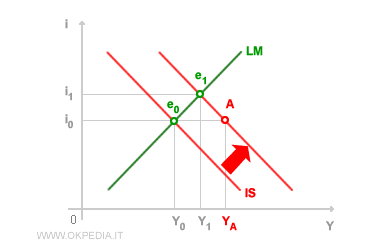
Objective of Expansionary Fiscal Policy. Typically, the aims are to promote economic growth, distribute wealth more equitably, and achieve greater fairness.
- Restrictive Fiscal Policy. This approach involves cutting public spending, increasing taxes (fiscal pressure(1)), and/or reducing transfers. Its intended effect is to lower aggregate demand and equilibrium income. In the IS-LM model, restrictive fiscal policy shifts the IS curve to the left.

Objective of Restrictive Fiscal Policy. The main goals usually include controlling price inflation caused by excessive domestic demand, reducing public debt, and managing the budget deficit.
Instruments of Fiscal Policy
The key tools and levers of fiscal policy include:
- Public Spending
The government can influence the economy through public expenditure (e.g., building infrastructure, roads, ports, schools, hospitals, etc.). - Taxation
By adjusting the tax burden (taxes, levies, and duties), the government can indirectly impact national income. - Transfers
The government can directly affect national income by providing subsidies or transfers to private entities (e.g., business subsidies, unemployment benefits, basic income, etc.).
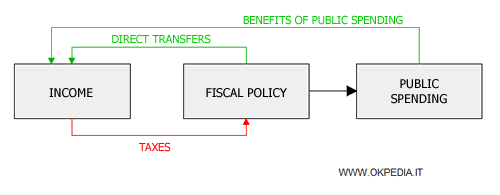
Funding Fiscal Policy
Public spending is generally financed through the following sources:
- Taxation of Households and Businesses
Fiscal policy is funded primarily through public revenue generated from taxes, levies, and duties imposed on households and businesses. - Public Debt
The state issues and sells government bonds in the market to finance deficit spending through public debt.Note. Public debt is a major source of funding for public expenditure in modern economies. However, if it becomes excessive, it can limit the government's ability to use fiscal policy effectively, as debt interest payments increase spending and worsen the public balance.
- Accommodative Monetary Policy
The central bank may adopt an expansionary monetary policy to facilitate government deficit spending.Note. In the Eurozone, monetary policy is managed by the ECB (European Central Bank). Therefore, individual member states can no longer independently implement an expansionary and accommodative monetary policy.

Effectiveness of Fiscal Policy
In the IS-LM model, the effectiveness of fiscal policy in terms of influencing income (production) depends on the slope and position of both the IS and LM curves.
Generally, fiscal policy is more effective when the LM curve is relatively flat (horizontal) and the IS curve is steeper (vertical).
A key factor in determining the effectiveness of fiscal policy is the sensitivity (h) of money demand to changes in interest rates.
If the sensitivity to interest rate changes is very low (h=0), the LM curve becomes vertical, rendering fiscal policy ineffective (according to the classical school hypothesis).
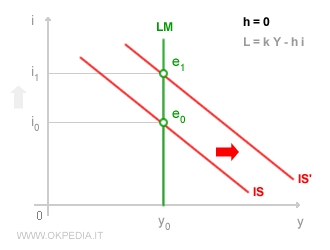
Conversely, if sensitivity to interest rate changes is extremely high (h=∞), the LM curve flattens, making fiscal policy effective (as per the Keynesian school hypothesis).
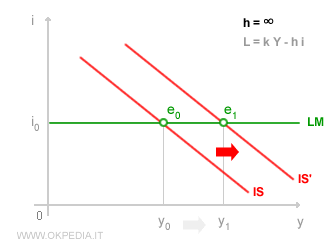
Note. British economist John Maynard Keynes developed his theory in the 1930s following the Great Depression of 1929. During that period, entrepreneurs and investors preferred to hoard cash rather than invest in productive activities due to negative future outlooks (a situation known as the liquidity trap). In such circumstances, monetary policy becomes ineffective, and the economy remains in a state of underemployment. Thus, policymakers intervene with public spending (fiscal policy) to revive the economy and restore investor confidence.
Limitations of Fiscal Policy
Some common criticisms of using fiscal policy include:
- Crowding Out of Private Investment. The positive impact of an expansionary fiscal policy on income can be offset by the crowding-out effect on private investments. Increased public spending may drive up market interest rates, discouraging private investments.

Explanation. To finance increased public spending, the government issues bonds and must offer higher interest rates to attract investors. This raises the market interest rate from i0 to i2. The resulting increase in interest rates reduces private investments, thereby dampening the positive impact of the expansionary fiscal policy. In this case, income grows only from Y0 to Y2 rather than reaching Y1. Essentially, public spending partially replaces private investments instead of stimulating them.
- The Rigidity of Public Spending. Public spending is a tool with a high degree of rigidity, due to the complexities of organizing and implementing spending on real goods and services. The real effects of public spending often materialize only after several years.
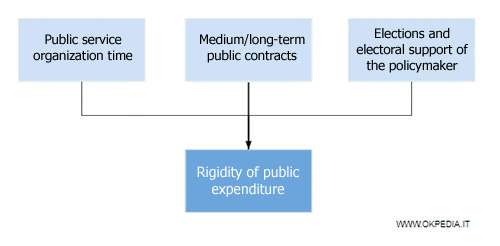
Furthermore, public investments usually involve medium- to long-term contracts, making them difficult to adjust in the short term.Note. The rigidity of public spending also has political implications. Policymakers who decide to cut public spending risk losing voter support and may not be re-elected, especially if the cuts affect public services (such as education, healthcare, and social security). Additionally, public spending is often used as a tool to gain electoral support.
- Tax Pressure. Fiscal policy can have a restrictive effect on aggregate demand if it is financed through higher taxes on taxpayers’ income, increasing the overall tax burden. This reduces the disposable income of private entities (households and businesses), dampening both consumption and investment.

Note. Excessive taxation on private income has numerous economic repercussions, including encouraging tax evasion and avoidance, discouraging foreign capital inflows, and prompting domestic businesses to relocate abroad.
- Uncertain Effect on Private Investments. While reducing taxes generally increases household consumption, its effect on business investments is less certain, as it also depends on the medium- and long-term expectations of entrepreneurs and investors.
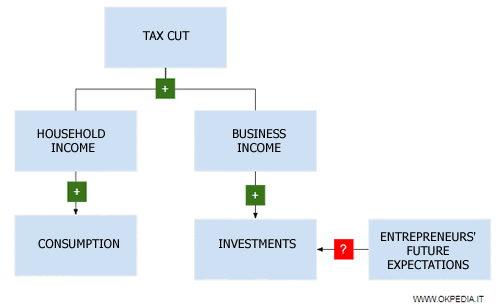
Example. An expansionary fiscal policy reduces the tax burden on households and businesses. The resulting increase in household disposable income (Yd) boosts consumption (C) through the marginal propensity to consume (c). However, the increase in businesses' net income may not lead to a rise in investments (I) if their outlook on the future is pessimistic. In such cases, business owners may choose to hoard the additional liquidity and delay investment decisions.
